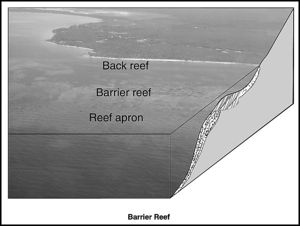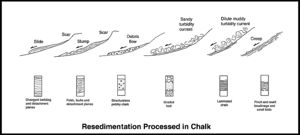Difference between revisions of "Carbonate reservoir"
Cwhitehurst (talk | contribs) |
Cwhitehurst (talk | contribs) |
||
| Line 112: | Line 112: | ||
==Subtidal and intertidal complexes== | ==Subtidal and intertidal complexes== | ||
| − | [[File:M91FG199.JPG|thumb|300px|{{figure number|5}}The upper photograph shows a Carbonate tidal flat on Andros Island, Bahamas. The tidal channel is about 150 m (492 ft) wide at the bottom of the photograph. The lower diagram shows three tidal flat reservoir cycles in the Permian San Andres dolomite of the northern Delaware basin in New Mexico and Texas (after Shinn, 1983 | + | [[File:M91FG199.JPG|thumb|300px|{{figure number|5}}The upper photograph shows a Carbonate tidal flat on Andros Island, Bahamas. The tidal channel is about 150 m (492 ft) wide at the bottom of the photograph. The lower diagram shows three tidal flat reservoir cycles in the Permian San Andres dolomite of the northern Delaware basin in New Mexico and Texas (after Shinn).<ref name=Shinn> Shinn, E. A., 1983, [http://archives.datapages.com/data/specpubs/carbona3/data/a043/a043/0001/0150/0171.htm Tidal flat environment], in P. A. Scholle, D. G. Bebout, and C. H. Moore, eds., Carbonate depositional environments: [http://store.aapg.org/detail.aspx?id=656 AAPG Memoir 33], p. 171–210.</ref> Repeated transgression and regression create cycles of tidal flat reservoirs, each sealed by impermeable anhydritic supratidal facies toward the north. Reprinted with permission from the AAPG.]] |
| − | The shelf interior in carbonate systems commonly shoals to a tidal flat environment that may be extensive in area ([[:File:M91FG199.JPG|Figure 5]]). The highest porosities and permeabilities are found in the subtidal to intertidal facies with the best reservoir quality in tidal channel sediments. Supratidal sediments show the poorest reservoir quality and are typically barriers to vertical flow | + | The shelf interior in carbonate systems commonly shoals to a tidal flat environment that may be extensive in area ([[:File:M91FG199.JPG|Figure 5]]). The highest porosities and permeabilities are found in the subtidal to intertidal facies with the best reservoir quality in tidal channel sediments. Supratidal sediments show the poorest reservoir quality and are typically barriers to vertical flow.<ref name=Shinn /> In arid environments, supratidal sabkha may be found. The evaporites can act as internal seals.<ref>Wilson, J. L., 1980, A review of carbonate reservoirs, in A. D. Miall, ed., Facts and principles of world petroleum occurrence: Canadian Society of Petroleum Geologists Memoir 6, p. 95–115.</ref> |
Tidal flat mudstones can be extensively dolomitized to form significant reservoir intervals. Examples of this are found in reservoirs of the Ordovician Ellenburger Formation in the United States, the Ordovician Red River Formation of the Williston basin, the Permian Basin carbonates of Texas, and the Cretaceous offshore of west Africa. | Tidal flat mudstones can be extensively dolomitized to form significant reservoir intervals. Examples of this are found in reservoirs of the Ordovician Ellenburger Formation in the United States, the Ordovician Red River Formation of the Williston basin, the Permian Basin carbonates of Texas, and the Cretaceous offshore of west Africa. | ||
Revision as of 20:38, 20 August 2015
| Oil Field Production Geology | |
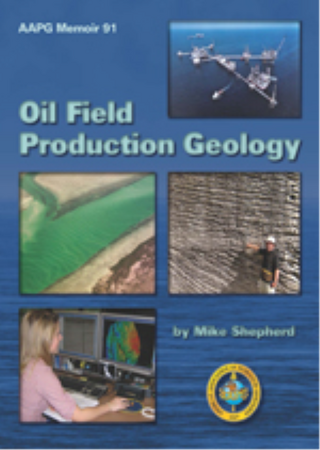
| |
| Series | Memoirs |
|---|---|
| Part | Depositional Environments and their Flow Characteristics |
| Chapter | Carbonate Reservoirs |
| Author | Mike Shepherd |
| Link | Web page |
| PDF file (requires access) | |
| Store | AAPG Store |
THIS PAGE IS UNDER CONSTRUCTION
A significant proportion of the world's oil reserves are found in carbonate reservoirs. Many of these are located in the Middle East, Libya, Russia, Kazakhstan, and North America. Some very large oil fields have carbonate reservoirs, including the largest conventional oil field in the world, the Ghawar field of Saudi Arabia.
The reason for the very large size of some carbonate reservoirs is not surprising when one considers the sheer scale of even modern-day carbonate settings. The shallow submerged platform area of the Bahamas extends more than 400 km (248 mi) north–south and covers an area of about 125,000 km2 (48,263 mi2). The size of individual sediment bodies on the Bahama Banks can be impressive too (Figure 1). The Joulters Cay ooid shoal is a single carbonate sand body with a mobile border 25 km (15 mi) long and between 0.5 and 2 km (0.3 and 1.2 mi) wide.[1]
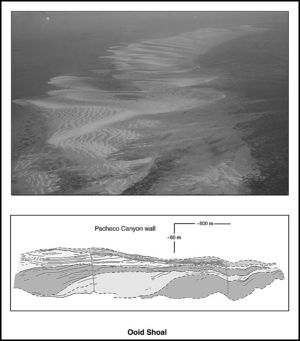
Carbonates are different from sandstones
Carbonate sediments have several features that set them apart by comparison with siliciclastics. Carbonate sediments tend to form and be deposited in situ, with enormous volumes of calcareous material provided by the death, disintegration, or digestion of plant and animal matter.[3] The coarser material tends not to be widely spread or abraded by waves and currents. Consequently, uniform grain sorting is not a major characteristic of carbonates. There can be a great diversity of grain sizes and shapes in most carbonate sediments compared to sandstones.
There are some similarities to siliciclastic environments. Various sedimentary bodies such as beaches, barrier islands, shelf sediments, gravity flows, and dune sands are also found in carbonate settings.
Many carbonate reservoirs offer a challenge to the production geologist
Carbonate reservoirs can be difficult to develop for a variety of reasons. They generally have poorer recoveries than siliciclastic sediments (e.g., Sun and Sloan).[4] A combination of depositional geometry and diagenesis creates highly heterogeneous reservoirs (Table 1). They can have lower primary recoveries as connected volumes may be areally limited with no contact to a large aquifer. The lower energy drive mechanisms such as solution gas drive are common. Heterogeneity at all the reservoir scales can make them a challenge to model, and it is not an easy task to make reliable predictions about their production performance. Reservoir management is difficult because the accurate targeting of production and injection wells is problematic, and sweep may be inefficient as a result of this.
| Characteristic | Favorable for Reservoir Development | Unfavorable for Reservoir Development |
|---|---|---|
| Carbonates form highly heterogenous reservoirs | Generally have lower recoveries than sandstone reservoirs; difficult to locate wells | |
| Generally do not have large aquifers | Poor primary recoveries | |
| Tend toward oil-wet behavior | Early water breakthrough and high water production rates | |
| Brittle rocks and commonly fractured | Fractures can create widespread connectivity in an otherwise heterogenous matrix rock | Can form thief zones with rapid water breakthrough |
| Common high-frequency cycles on a meter cycle | Numerous hydraulic units and highly layered reservoirs | |
| Shingled geometries can be present | Potential to create bypassed oil volumes, particularly in shingled oolites | |
| Diagenesis can significantly modify the original depositional connectivity in carbonate sediments | Dolomitization can potentially create good connectivity by modifying fine-grained sediments | Pervasive cements can significantly reduce rock properties and connected volumes |
Pore sizes in carbonates vary from micron scale to cave systems. Carbonates with vuggy porosity can store significant volumes of oil, yet sometimes the vugs are largely unconnected, yielding low flow rates. Tiny pores on a micron scale can form a high component of the porosity. The porosity may look impressive on logs, yet much of this may be microporosity and unproduceable.[5][6] The petrophysical analysis of carbonate reservoirs is difficult and prone to greater uncertainty than with sandstone reservoirs. The uncertainty in the determination of water saturation, effective porosity, net pay, and permeability will impact the estimation of in-place volumes and reserves. Carbonates have a tendency to oil-wet characteristics or show mixed wettability. Typical behavior in oil-wet systems includes early water breakthrough and high water production rates (see Chapter 4, this publication). Carbonates can have thick transition zones in reservoirs with low matrix permeability.[7] Residual oil saturations can also be high.[8] [9]
Carbonates are typically brittle rocks and are commonly fractured. The fractures can be a major component of the field performance, enhancing effective permeability and creating connectivity within otherwise heterogeneous reservoirs. Fractures will influence sweep patterns and will cause considerable variability in well-flow rates. Thief zones in fractures and high-permeability intervals can cause early water breakthrough.
Geometry
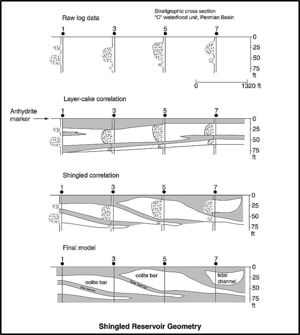
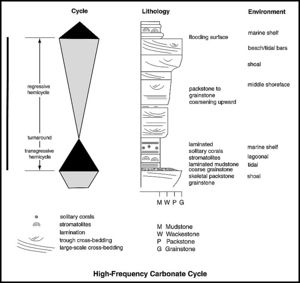
Carbonate sediments tend to show a ribbon-like geometry and are less commonly developed as widespread sheets. Examples of both geometries are shown by two of the major carbonate reservoir intervals in the Middle East.[12] Sediments of the Permian–Triassic Khuff Formation were deposited on a very low relief shelf, sheltered from the open ocean by a barrier reef. These show a layer-cake geometry consisting of interbedded mudstones and fine-grained grainstones.[13] By contrast, sedimentation in the Jurassic Arab Formation occurred on a shelf differentiated into shallow shoals and intrashelf basins. These exhibit a progradational geometry.[14]
Carbonate sediments with ribbon geometries show a complex lateral facies progression in map view. A tendency for lateral accretion in successive cycles creates a subtle shingled geometry, which can make accurate correlation difficult (see Chapter 10, this publication, and Figure 2). For example, laterally accreting grainstones show a shingled geometry on a kilometer scale in Albian carbonates in northern Mexico (Figure 1).[2] It can be a mistake to fit a layer-cake geometry to these systems because this results in reservoir models where lateral connectivity is predicted to be more extensive than is the case.[15] Facies belts may be difficult to define as lithofacies variation in carbonates is frequently transitional rather than sharp.
Carbonate sedimentation is very rapid and the build-up of carbonate sediment can exceed sea-level rise in a short period of time. For example, Neumann and Land[16] estimated that the carbonate sediment accumulation rate in the Bight of Abaco in the Bahamas is 120 mm (5 in.) per thousand years. This is about three times the estimated subsidence rate of 38 mm (1.4 in.) per thousand years. The phrase carbonate factory is commonly used to describe the manner in which large volumes of sediment are produced on tropical shelfs.
Vertically, carbonates can be characterized by high-frequency stacking, with shoaling-upward cycles a few meters thick. Westphal et al.[11] described high-frequency depositional cycles from the Mississippian Madison Formation in the Wind River Basin of Wyoming. The cycles occur over a meter-scale thickness and consist of a lower transgressive and an upper regressive hemicycle. The transgressive hemicycle is dominated by tidal flat sediments (laminated mudstone and wackestone) and subtidal deposits (e.g., stromatilites). The regressive hemicycle comprises high-energy carbonate sand-shoal facies (Figure 3).
High-frequency upward-shoaling cycles commonly comprise individual hydraulic or flow units within carbonate reservoirs.[17] Porosity variation in carbonate reservoirs occurs at the scale of high-frequency cycles.[18] Larger scale trends in porosity variation can also occur at the systems tract or sequence level.[19]
The measurement of carbonate body dimensions is a topic that gets less attention than is the case for siliciclastic reservoirs. A recent exception is Qi et al.,[20] where geometric data for ooid shoal, tidal flat, and eolian carbonate macroforms were used for constructing a 3-D reservoir model for the Big Bow and Sand Arroyo Creek fields in Kansas. The model has four zones with the ooid grainstone lithofacies showing the highest porosities and permeabilities. These form large linear shoals associated with structural highs. The model can be used to make predictions as a result of the simple zonation, large macroforms, and a reasonable correspondence between facies and rock properties. Many carbonate reservoirs are more complex than this and rather more difficult to model.
There may be several reasons why there is not so much measured data available for carbonate body dimensions compared to siliciclastics. Many carbonate reservoirs are characterized by rock types instead of lithofacies. Here, a combination of lithofacies and diagenesis acts as a control on rock properties. Thus, it is not always possible to make a predictive rock property model of a carbonate reservoir that is allied to the lithofacies model as in the example above.
The choice of reservoir analogs can be problematic. Carbonate environments have changed substantially over geological time by comparison to siliciclastic environments; for example, the type of organism responsible for building reefs has varied throughout the geological record. For this reason, it is advisable to select an outcrop analog that was deposited at roughly the same time as the carbonate reservoir interval under investigation.[21]
Importance of diagenesis
Diagenetic alteration tends to be the rule rather than the exception in carbonates and will act to modify or obscure the original depositional porosity.[22] It can happen that the best potential reservoir intervals such as reefs have their porosity totally occluded by diagenetic cement. However, poor or nonreservoir facies such as tidal mud flats can be modified into reservoir rock by dolomitization. Diagenetic reactions can reorganize the pore system significantly, commonly crosscutting stratigraphic boundaries. The process of rock property characterization in carbonates has to take into account both the stratigraphic and diagenetic model as a result.[23][24]
The diagenetic history of a carbonate reservoir can be complex, involving various phases of cementation, dissolution, compaction, and mineral transformation.[25] Early oil migration can inhibit further diagenesis and preserve porosity in carbonate reservoirs.[26]
Dolomitization is the process by which calcium carbonate is altered to the magnesium-rich carbonate mineral dolomite. It has been estimated that about 80% of the reserves in the carbonates of the United States are in dolomite with 20% in limestone.[27] Dolomitization materially affects the pore distribution of carbonate sediments. Dolomitization can act to eliminate heterogeneities in minor lithofacies that would otherwise form barriers or extensive baffles. Muddy carbonates can be transformed into porous dolomites with good intercrystalline connectivity. Dolomites tend to show higher porosities at increased depths of burial by comparison to limestones.[19]
The process of dolomitization requires a large source of magnesium ions and a fluid transport path for the magnesium to move through the pore space. Several mechanisms have been proposed to explain dolomitization.[28] For instance, in the reflux model of dolomitization, dolomite can form where hypersaline conditions exist in peritidal, lagoonal, and restricted basinal environments. Intense evaporation in the tropical heat will result in brine concentrations. The precipitation of gypsum and anhydrite removes calcium from the saline fluids, leaving a magnesium-rich residual brine. The dense, concentrated brine solution will subsequently filter down, reacting with the underlying sediments to form dolomite.[29]
Rock types in carbonates
It is an established procedure to characterize the rock properties of carbonates by rock types instead of lithofacies.[23][24] These are textural classes that are related to both depositional and diagenetic processes. Sandstone rock properties are dominated by intergranular pore systems, which exhibit a strong lithofacies control on grain size, shape, and sorting. By contrast, carbonate pore systems are much more complex.[30] The primary intergranular porosity is more variable because of the greater range in grain sizes and shapes. In addition, skeletal materials common in carbonates will show intraparticle porosity. The primary rock texture will often then be overprinted by postdepositional leaching, replacement, and cementation to form an even more complex pore network.[22]
Typical settings for carbonate reservoirs
Typical settings for carbonate reservoirs include
- organic build-ups including reefs;
- grainstone shoals on shelves;
- subtidal and intertidal complexes;
- leached zones below unconformities;
- karst; and
- chalk.
Organic build-ups including reefs
Organic build-ups and reefs can be excellent reservoirs where the primary porosity has been preserved and is not occluded by internal sediments and secondary cements. They have the highest recovery factors among carbonate sediments according to Sun and Sloan.[4] Vertical permeability is typically good, and large pore systems are common in the reef core and in the near reef facies.
Major reef-forming organisms at various periods in geological time have included, amongst others, corals, algae, stromatoporoids, and rudist bivalves. Four main periods of reef reservoir formation have been described by Kiessling et al.[31] These are the Silurian to Late Permian, the Late Jurassic, the middle Cretaceous, and the Miocene. Late Middle–Late Devonian reef reservoirs are particularly common worldwide.
Barrier reefs form thick massive sheets or ribbons parallel to the shoreline (Figure 4). Some of these can be very long, up to many tens of kilometers in length. The reef is the result of the growth of the calcareous framework created by the reef-forming organisms. This framework is interspersed with sands, silts, and muds that have formed from the erosion of the reef by biological activity and the occasional storm. The reefs themselves can act as a source of sediment, which may either be transported landward or seaward. The back reef can show impressive areas of skeletal sand deposition up to several kilometers wide. Localized patch reefs are also found here. Reef aprons form seaward from the reef and are composed of silt to boulder-size debris, derived from the reef front. The reef apron sediments can be stabilized or encrusted by in-situ fore reef biota such as foraminifera, sponges, or algae.
Barrier reef reservoirs are found in major oil fields such as the Oligocene to upper Eocene Kirkuk field of Iraq or the Lower Cretaceous fields found in the Golden Lane of Mexico.[32]
Organic build-ups tend to be found encased in marine shales and/or evaporites. Massive reservoirs of this type are observed in relatively small dome-shaped reefs. The more complex pinnacle reef systems display a layered and lenticular distribution of zones with better reservoir properties. Where fractures occur, these can connect isolated porous and permeable zones into a dynamically unified system. Low-energy drive mechanisms tend to operate in these isolated systems. Pressure maintenance is often required. Secondary recovery operations can be efficient because the organic build-ups are typically thick and well connected.[4]
Grainstone shoals on shelves
Grainstone shoals form large elongate sheets that can extend for tens of kilometers in length (Figure 1). They are commonly found on the seaward edges of banks, platforms, and shelves.[33] The grainstone shoals are composed of sand-size grains, which can be skeletal or non-skeletal in origin. The latter includes ooids. Ooids are coated grains with a calcareous outer cortex and nuclei that are variable in composition.[25] Oolites are rocks formed from ooids. Where oolites are relatively uncemented and not too deeply buried, they can form world-class productive intervals such as in the Jurassic Arab-D reservoirs of the Middle East. However, oolites can undergo cementation such that the interparticle volume is pervasively cemented, whereas the ooids dissolve out to form oomoldic porosity. The ooids are typically poorly connected. One example, described from the Upper Jurassic Smackover Formation in Arkansas and Louisiana, shows 30% porosity but only one millidarcy or less permeability.[33] Grainstone shoals are known to accrete laterally as a series of shingled units that may be compartmentalized by muddy barriers.[10] Minor lateral heterogeneity occurs where tidal channels cut the ooid shoals.
Subtidal and intertidal complexes
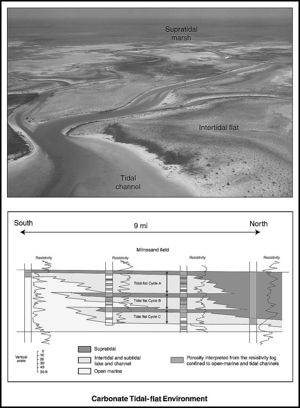
The shelf interior in carbonate systems commonly shoals to a tidal flat environment that may be extensive in area (Figure 5). The highest porosities and permeabilities are found in the subtidal to intertidal facies with the best reservoir quality in tidal channel sediments. Supratidal sediments show the poorest reservoir quality and are typically barriers to vertical flow.[34] In arid environments, supratidal sabkha may be found. The evaporites can act as internal seals.[35]
Tidal flat mudstones can be extensively dolomitized to form significant reservoir intervals. Examples of this are found in reservoirs of the Ordovician Ellenburger Formation in the United States, the Ordovician Red River Formation of the Williston basin, the Permian Basin carbonates of Texas, and the Cretaceous offshore of west Africa.
Karstification and paleocave systems
Karstified landscapes and paleocave systems form an important class of carbonate reservoirs. Caves present within a limestone bedrock are liable to collapse on compaction, creating a collapse breccia and with associated fracturing of the roof rock. Not all caves fall in with increasing burial; some can survive. When these are penetrated during drilling, the bit can suddenly drop several meters and large losses of drilling mud into the cave system can ensue.
Numerous cycles of cave formation and subsequent collapse can result in coalescing collapsed cave systems of considerable size, typically hundreds to several thousands of meters across. These systems may be mappable on 3-D seismic data. Collapse and sag structures form circular karst features that may be discernable from amplitude displays (Loucks, 1999).
Paleocave systems contain some very large hydrocarbon accumulations, such as the Lower Ordovician Puckett field in west Texas (Loucks and Anderson, 1980), in the Permian Yates field in west Texas (Craig, 1988), and in the Lower Cretaceous Golden Lane fields of eastern Mexico ([32]; Coogan et al., 1972).
Karst and paleocave reservoirs can show poor recoveries. Fracture production is common, and the recovery is sensitive to the nature of the fracture framework. The better reservoirs have a fracture system that connects to an aquifer with a water drive operating. However, overproduction of these systems is detrimental to recovery because this will result in rapid water breakthrough and an early production decline.[4]
Chalk
Chalk is very fine-grained carbonate sediment, comprising skeletal calcitic debris of algae platelets. Porosity in chalk can be high, sometimes as high as 40–50%. Nevertheless, given the very fine-grained nature of the rock, permeabilities are low; 1–7 md is typical of the productive intervals. Factors influencing porosity preservation in chalk are overpressure, early oil migration, burial depth, chalk lithofacies, mud content, and grain size (Scholle, 1977; Nygaard et al., 1983; D'Heur, 1986; Brasher and Vagle, 1996). A correlation is found between the clay content of the chalk and the degradation of reservoir quality; clay hinders early lithification. As a result, clay-rich chalks are less rigid and will tend to undergo more compaction (Kennedy, 1987). It is a common pattern in chalk oil fields to find the highest porosity in the crest of the field, decreasing incrementally toward the oil-water contact (D'Heur, 1986). This character may result from the race for space between oil migration and cementing fluids (see Chapter 12, this publication). The permeability in the water leg can be so poor that chalk fields are unlikely to have significant aquifers.
Chalk reservoirs can show strong permeability layering. Pelagic chalk is usually non-net reservoir although under favorable circumstances it can be productive (Megson and Tygesen, 2005). Pelagic or autochthonous chalk results from the slow settling of sediment on the sea floor. Pervasive early cementation and extensive bioturbation significantly reduce the porosity and permeability from an early stage.
Pelagic chalk on the seabed is easily disturbed and remobilized. Clean chalk lacks any significant sediment cohesion as it has no unbalanced interparticle electric charges or platy interlocking grains to hold it together (Bramwell et al., 1999). Processes tending to redeposit chalk include debris flows, turbidity currents, slumps, and slides (Figure 6) (Kennedy, 1987).
Redeposited, allochthonous chalk typically shows much better porosities and permeabilities compared to autochthonous chalk in the same interval. The rock properties are thought to have been enhanced by several processes (Kennedy, 1987; Taylor and Lapre, 1987):
- The chalk is loosened up as it is remobilized, with the break up of any early diagenetic cements that may already have formed.
- Porosity is preserved as a consequence of minimal dewatering on burial.
- The redeposited chalk tends to form as thicker masses and this results in the bulk of the sediment escaping bioturbation and early cementation at the sediment-sea water interface.
Given the low permeability of chalks, the presence of fractures can significantly enhance the productivity of chalk fields (see Chapter 14, this publication). Sorenson et al. (1986) differentiated between two classes of producing chalk fields in the North Sea: low-porosity chalk (15–30%) and permeabilities in the range of 0.2–1 md, which need an extensive natural fracture system to be productive, and high porosity chalk with 30–50% porosity and permeabilities between 1–10 md.
Horizontal wells are used to develop chalk fields (Megson and Hardman, 2001). Permeabilities are too low for conventional wells to be effective. Long horizontal wells, commonly 2 km or more in length, maximize the permeability-thickness and productivity of chalk fields. Fracture stimulation is used to enhance productivity (e.g., Cook and Brekke, 2004). Waterfloods can be highly effective in chalk because the fine capillary structure will draw in water very efficiently, displacing much of the oil (Surlyk et al., 2003). The injection wells should be drilled to avoid any open fractures that are likely to connect up with production wells, as rapid water breakthrough will ensue.
References
- ↑ Major, R. P., D. G. Bebout, and P. M. Harris, 1996, Facies heterogeneity in a modern ooid sand shoal—An analog for hydrocarbon reservoirs: Bureau of Economic Geology, Geological Circular 96-1, University of Texas at Austin, 30 p.
- ↑ 2.0 2.1 Osleger, D. A., R. Barnaby, and C. Kerans, 2004, A laterally accreting grainstone margin from the Albian of northern Mexico: Outcrop model for Cretaceous carbonate reservoirs, in G. M. Grammer, P. M. Harris, and G. P. Eberli, eds., Integration of outcrop and modern analogs in reservoir modeling: AAPG Memoir 80, p. 93–107.
- ↑ Ginsburg, R. N., and N. P. James, 1974, Holocene carbonate sediments of continental shelves, in C. A Burk and C. L. Drake, eds., The geology of continental margins, New York, Springer-Verlag, p.137–155.
- ↑ 4.0 4.1 4.2 4.3 Sun, S. Q., and R. Sloan, 2003, Quantification of uncertainty in recovery efficiency predictions: Lessons learned from 250 mature carbonate fields: Presented at the Society of Petroleum Engineers Annual Technical Conference and Exhibition, October 5–8, 2003, Denver, SPE Paper 84459, 15 p.
- ↑ Pittman, E. D., 1971, Microporosity in carbonate rocks: AAPG Bulletin, v. 55, no. 10, p. 1873–1878.
- ↑ Cantrell, D. L., and R. M. Hagerty, 1999, Microporosity in Arab Formation carbonates, Saudi Arabia: GeoArabia, v. 4, no. 2, p. 129–154.
- ↑ Masalmeh, S. K., I. Abu Shiekah, and X. D. Jing, 2005, Improved characterization and modeling of capillary transition zones in carbonate reservoirs: Presented at the International Petroleum Technology Conference, Society of Petroleum Engineers, November 21–23, Doha, Qatar, SPE Paper 10238, 16 p.
- ↑ Holtz, M., S. C. Ruppel, and C. R. Hocott, 1992, Integrated geologic and engineering determination of oil-reserve growth potential in carbonate reservoirs: Journal of Petroleum Technology, v. 44, no. 11, SPE Paper 22900, p. 1250–1257.
- ↑ Kamath, J., R. F. Meyer, and F. M. Nakagawa, 2001, Understanding waterflood residual oil saturation of four carbonate rock types: Presented at the 2001 Society of Petroleum Engineers Annual Technical Conference and Exhibition, September 30–October 3, 2001, New Orleans, Louisiana, SPE Paper 71505, 10 p.
- ↑ 10.0 10.1 Sneider, R. M., and J. S. Sneider, 2001, New oil in old places: The value of mature-field development, in M. W. Downey, J. C. Threet, and W. A. Morgan, eds., Petroleum provinces of the twenty-first century: AAPG Memoir 74, p. 63–84.
- ↑ 11.0 11.1 Westphal, H., G. P. Eberli, L. B. Smith, G. M. Grammer, and J. Kislak, 2004, Reservoir characterization of the Mississippian Madison Formation, Wind River basin, Wyoming: AAPG Bulletin, v. 88, no. 4, p. 405–432
- ↑ Ehrenberg, S. N., P. H. Nadeau, and A. A. M. Aqrawi, 2007, A comparison of Khuff and Arab reservoir potential throughout the Middle East: AAPG Bulletin, v. 91, no. 3, p. 275–286
- ↑ Alsharhan, A. S., 2006, Sedimentological character and hydrocarbon parameters of the middle Permian to Early Triassic Khuff Formation, United Arab Emirates: GeoArabia, v. 11, p. 121–158.
- ↑ Meyer, F. O., and R. C. Price, 1992, A new Arab-D depositional model, Ghawar field, Saudi Arabia: Presented at the Society of Petroleum Engineers 8th Middle East Oil Show, SPE Paper 25576, 10 p.
- ↑ Tinker, S. W., 1996, Building the 3-D jigsaw puzzle, applications of sequence stratigraphy to 3-D reservoir characterization, Permian Basin: AAPG Bulletin, v. 80, no. 4, p. 460–484.
- ↑ Neumann, A. C., and L. S. Land, 1975, Lime mud deposition and calcareous algae in the Bight of Abaco, Bahamas: A budget: Journal of Sedimentary Petrology, v. 45, no. 4, p. 763–786.
- ↑ Kerans, C., F. J. Lucia, and R. K. Senger, 1994, Integrated characterization of carbonate ramp reservoirs using Permian San Andres Formation outcrop analogs: AAPG Bulletin, v. 78, no. 2, p. 181–216.
- ↑ Ehrenberg, S. N., 2004, Factors controlling porosity in Upper Carboniferous-Lower Permian carbonate strata of the Barents Sea: AAPG Bulletin, v. 88, no. 12, p. 1653–1676.
- ↑ 19.0 19.1 Ehrenberg, S. N., G. P. Eberli, M. Keramati, and S. A. Moallemi, 2006, Porosity-permeability relationships in interlayered limestone-dolostone reservoirs: AAPG Bulletin, v. 90, no. 1, p. 91–114.
- ↑ Qi, L., T. R. Carr, and R. H. Goldstein, 2007, Geostatistical three-dimensional modeling of oolite shoals, St. Louis Limestone, southwest Kansas: AAPG Bulletin, v. 91, no. 1, p. 69–96.
- ↑ Markello, J. R., R. Koepnick, and L. E. Waite, 2006, The carbonate analogs through time (CATT) hypothesis—A systematic and predictive look at Phanerozoic carbonate reservoirs: AAPG Search and Discovery Article 40185, 5 p.
- ↑ 22.0 22.1 Jardine, D., and J. W. Wilshart, 1982, Carbonate reservoir description: Presented at the International Petroleum Exhibition and Technical Symposium of the Society of Petroleum Engineers, March 18–26, 1982, Beijing, China, SPE Paper 10010, 35 p.
- ↑ 23.0 23.1 Lucia, F. J., 1995, Rock-fabric/petrophysical classification of carbonate pore space for reservoir characterization: AAPG Bulletin, v. 79, no. 9, p. 1275–1300.
- ↑ 24.0 24.1 Lucia, F. J., 1999, Carbonate reservoir characterization: Berlin, Springer-Verlag, 226 p.
- ↑ 25.0 25.1 Tucker, M. E., and V. P. Wright, 1990, Carbonate sedimentology: London, Blackwell, 496 p.
- ↑ Neilson, J. E., N. H. Oxtoby, M. D. Simmons, I. R. Simpson, and N. K. Fortunatova, 1998, The relationship between petroleum emplacement and carbonate reservoir quality: Examples from Abu Dhabi and the Amu Darya Basin: Marine and Petroleum Geology, v. 15, p. 57–72.
- ↑ North, F. K., 1985, Petroleum geology: Boston, Allen and Unwin, 619 p.
- ↑ Machel, H. G., 2004, Concepts and models of dolomitization: A critical reappraisal, in C. J. R. Braithwaite, G. Rizzi, and G. Darke, eds., The geometry and petrogenesis of dolomite reservoirs: Geological Society (London) Special Publication 235, p. 7–63.
- ↑ Adams, J. E., and M. L. Rhodes, 1960, Dolomitization by seepage refluxion: AAPG Bulletin, v. 44, p. 1912–1920.
- ↑ Choquette, P. W., and L. C. Pray, 1970, Geologic nomenclature and classification of porosity in sedimentary carbonates: AAPG Bulletin, v. 54, no. 2, p. 207–250.
- ↑ Kiessling, W., E. Flugel, and J. Golonka, 1999, Paleoreef maps: Evaluation of a comprehensive database on Phanerozoic reefs: AAPG Bulletin, v. 83, no. 10, p. 1552–1587.
- ↑ 32.0 32.1 Viniegra-O, F., and C. Castillo-Tejero, 1970, Golden Lane fields, Veracuz, Mexico, in M. T. Halbouty, ed., Geology of giant petroleum fields: AAPG Memoir 14, p. 309–325.
- ↑ 33.0 33.1 Halley, R. B., P. M. Harris and A. C. Hine, 1983, Bank Margin, in P. A. Scholle, D. G. Bebout, and C. H. Moore, eds., Carbonate depositional environments: AAPG Memoir 33, p. 463–506.
- ↑ 34.0 34.1 Shinn, E. A., 1983, Tidal flat environment, in P. A. Scholle, D. G. Bebout, and C. H. Moore, eds., Carbonate depositional environments: AAPG Memoir 33, p. 171–210.
- ↑ Wilson, J. L., 1980, A review of carbonate reservoirs, in A. D. Miall, ed., Facts and principles of world petroleum occurrence: Canadian Society of Petroleum Geologists Memoir 6, p. 95–115.
